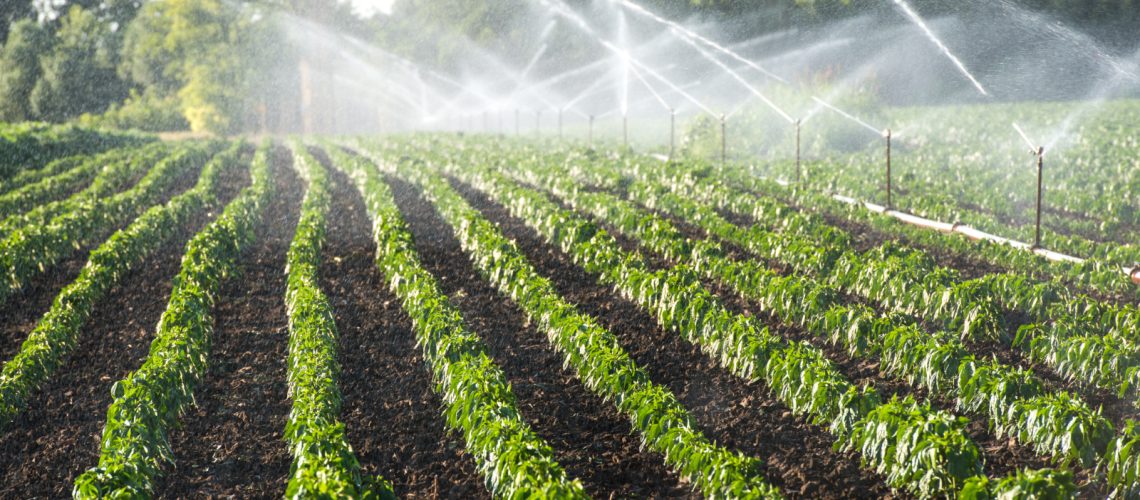Most agricultural irrigation systems fall under two broad categories: micro-irrigation and sprinkler irrigation. Sprinkler irrigation systems discharge water by spraying it over the land. The pressure pushes the water via sprinklers or through nozzles or perforations in pipelines forming a spray.
A high-speed turbine pump or centrifugal can be utilized in running sprinkler irrigation. A centrifugal pump is ideal when the distance to the pump inlet from the water surface is not more than 25 feet; otherwise, a turbine pump would be appropriate.
Advantages of sprinkler irrigation
- Enables saving of between 30 percent to 50 percent of water.
- There are no water conveyance channels, thus minimizing conveyance loss.
- Suitable for irrigation where the plant population per unit area is very high.
- Suitable for all kinds of soils apart from heavy clay.
- Assists in enhancing yields.
- Mobility of system helps system operation easy.
- Fit for undulating land.
- Minimizes soil compaction.
- Allows the use of chemicals and soluble fertilizers use.
- It saves land since no bunds are needed.
- Minimizes labor cost.
- Offers frost protection and assists in modification of microclimate.
Components of sprinkler irrigation system
The following are the major components of sprinkler irrigation system
- Filtration system pumping station
- Fertilizer tank
- HDPE or PVC Pipes
- Pressure gauges
- By-pass valve
- QRC Pump connector
- Control valves
- Service Saddle
- Sprinkler Nozzles
Types of agricultural sprinkler irrigation systems
Getting a sprinkler suitable for your farm is easy, but choosing the right type is the challenge. Here are some of the most common sprinkler systems available in the market today.
Center Pivots
Center Pivots is moving irrigation that is self-propelled, rotating around a central pivot point. The water is sprinkled along the length of the system pipe using either water pressure, hydraulic oil, or an electric motor. This system covers a circular area; thus, they are best adapted to square or round fields. Besides, it is suitable for gardens with a single crop like fruit or vegetables. While the costs of labor are low, installation costs could be higher.
For center pivots, here are some of the sprinkler options available:
- Low-Pressure Sprinklers – commonly known as spray nozzles, low-pressure sprinklers operate at pressures between 10 psi and 30 psi in a fixed 360-degree spray pattern. Due to the low pressure, it requires less energy and has a relatively small wetter radius.
- Medium Pressure Sprinklers – operating at pressures between 30 psi to 60 psi, medium pressure sprinklers have the advantage of energy-saving. They use low-angle impact sprinklers with higher pressure systems and lower application rates.
- High-Pressure Sprinklers – operating at pressure over 60 psi requires the most significant energy and low application rates. Its use is limited to fields with fine textures soils or sloped exceeding 10% to 15%.
Traveling Big Gun Sprinklers
Traveling gun sprinkles are equipped with a big gun or large sprinkler mounted on a wheeled truck with a plastic hose on a reel. It is mechanically moved across the field to spray water. This system generally releases between 100 GPM to 600 GPM and irrigates an approximate radius of 50 feet to 250 feet. Large farms prefer this irrigation system as it can irrigate the whole farm with minimal manual labor and a very short time.
There are two types of traveling big gun sprinklers:
- Cable-Tow Traveler Irrigation System – the machine used in this system propels itself through the field using a steel cable around a pulley or drum mounted on the gun cart. The power used to move the cable is either through an auxiliary engine, water piston, water turbine, or water motor. By changing the speed of the cable winch, the depth of water application is varied.
- Hose-pull Traveler irrigation System – consists of four components and is parked either at the middle or end of the travel lane. The hose fed with water is wound on the trailer-mounted hose reel, which pulls the sprinkler cart. The reel could be driven by water bellows, turbine, auxiliary engine, or water piston.
Solid Set Sprinklers
A solid set irrigation system comes with a portable above-ground aluminum pipe and sprinklers spaced at specific intervals along the line. This system is usually used on small fields or crops with high cash value like sod or vegetables. The labor requirements can range from high to low depending on the available pipe and how often the sets are moved. While the system is easy to operate, there is no way to move the lines because they cover the entire area once installed. In addition, this type of sprinkler can hinder garden operations like spraying, harvesting, and cultivating.
It would be best for those unfamiliar with sprinkler systems to contact experts and get their advice on which type is suitable for your farm. Contact Southwest Florida Service and Supply for your agricultural needs.

